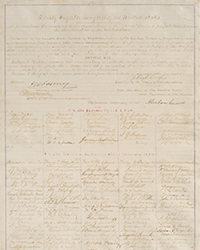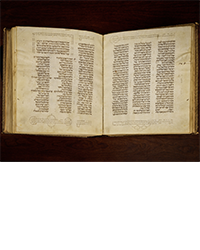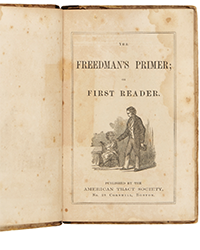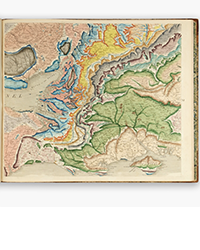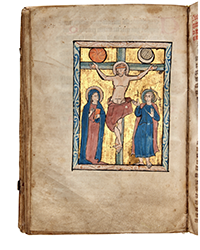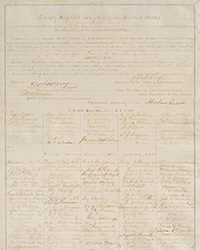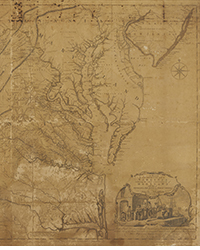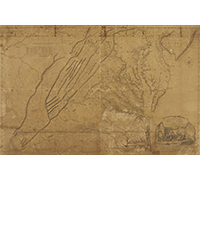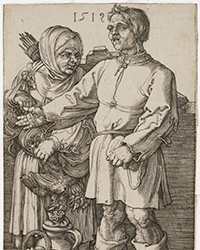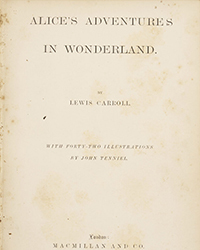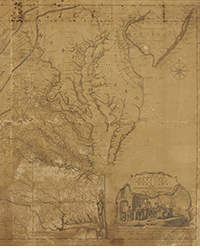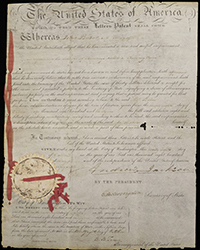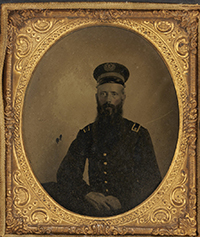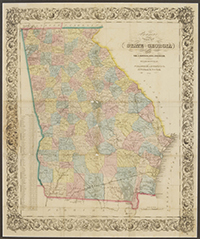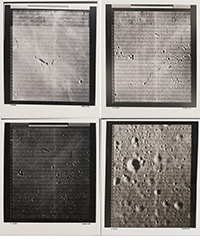In 1767, a peculiar book entitled Voyage Autour du Monde fait en 1764 & 1765 (Paris, 1767) reached the shores of France. This first edition of Commodore Byron’s voyage around the world shut the mouths of all the furious disciples of reason, who had so far denied the existence of a race of giants living in Patagonia, South America. At last! Here was the irrefutable proof, printed black on white, coming straight—or almost—from the mouth of the Commodore. But—wait! A race of giants—WTF?! as the young gentlemen of today would say.
The English edition of Byron’s travel came out in 1767 (London) and made it clear from its title page: “Contains (...) a minute and exact description of the Streights (sic) of Magellan, and of the Gigantic People called PATAGONIAS.” Nothing but the truth was to be expected from such a piece of work, which was to “remove the doubts (...) concerning some matters which have lately occasioned much altercation.” The French editor went straight to the point in his own preface: “The existence of a race of giants on the coast of Patagonia is no more dubious today; it’s even surprising it’s been a subject of controversy for so long.” He blamed the “so-called philosophers who dared not siding the opinion of the commoners,” before rejoicing that “the expedition of Commodore Byron has just set the records straight once and for all; and the exact and authentic reports of the crews of both vessels leave no room for pyrrhonism (or scepticism).” The English edition featured two engravings of the giants, but the French one reproduced the frontispiece only. It shows an English sailor handing a biscuit to a female Patagonian, who is twice as tall as him. Yet so touchy about the truth, the French publisher had the scene loosely redrawn—the Patagonians appear more handsome than on the original. Surprisingly, he didn’t pick up the second engraving that represents Byron himself, making presents to a bunch of gigantic Patagonians quietly sitting around him in a circle—they were gentle giants. The other notable difference with the English edition is the lengthy preface that retraces the various voyages to the Straight of Magellan linked to the myth of the giants of Patagonia—we only find a four-page index at the end of the English edition. Of course, it starts with the most legendary of all, Magellan’s.
Anatomy of A Lie
The reason why the particular relation of Byron’s travel, after so many contradictory ones, was supposed to settle the matter was that John Byron was a respected explorer, whose voyage couldn’t be any fresher. He had first sailed to the Straight of Magellan in 1742 alongside the famous George Anson, whose circumnavigation remains one of the most important travels of the 18th century. Byron’s ship, HMS Wager, had been shipwrecked on that occasion, and the navigator had remained there for several months before being taken prisoner by the Spaniards—he later published a relation of this travel. He had also served his country during the Seven Years’ War against France. In a word, he was no punk trying to make an impression. And if you couldn’t trust an English officer, then who could you trust?
In 1519, Ferdinand Magellan discovered the straight that still bears his name today during the first circumnavigation of all times. Unfortunately, the first man to circumnavigate the globe ever didn’t really circumnavigate the globe—he died halfway. Thus, when Pigafetta, one of the few survivors of the expedition, wrote the relation of this history-making travel, Magellan wasn’t there to confirm or to infirm a story “mingled with (...) circumstances that are equally fabulous and absurd, and that are only calculated to disguise truth in the habit of fiction,” read the index of the English edition. The crew, said Pigafetta, had been anchored for two months at Port San Julian (today’s Patagonia) when suddenly “a giant came to us, singing, dancing, and throwing dust over his head.” Since his feet were stuck into an animal fur, Magellan decided to call him Patagon—patagon meaning feet in Spanish; in fact, the name probably derives from Patagon, the giant character of Primalion, a chivalric novel of the time. According to Pigafetta, the taller Spaniards among the crew hardly reached the waist of the Patagonian! The complacent Abbot Feller, in his Dictionnaire Historique (Liège, 1790), offered an explanation: Magellan had met some Indians “probably taller than Negroes”; but he hadn’t examined them closely enough. Well, if we believe Pigafetta, he had! The author said they met dozens of giants, even capturing two of them with the intention to bring them back home—too bad they died on board shortly afterwards! Pigafetta’s relation, published in 1524, reminded the Europeans of the famous giants of Ovid’s Metamorphosis, who had rebelled against Jupiter. Had these warlike creatures sought refuge to Patagonia once scattered? Why not? The discovery of a new world was such a miracle that people were probably ready to accept anything.
The French editor of Byron’s travel reproduced a part of Pigafetta’s relation, but honestly concluded: “It was then natural to be suspicious.” Then, he added: “But the many relations that have followed should have convinced every one long ago; including the philosophers.” He then mentioned navigators like Argensola, Nuno de Silva, Sarmiento, who all claimed they had seen some giants—and even Thomas Cavendish and Admiral Van Noort, whose testimonies appeared more irrefutable. He quoted Sir Francis Drake’s relation, who “reported that the English saw, on the Coast of Magellan, some savages compared to whom the tallest Englishmen were very short.” What about Cordes and Wer who said that, when under attack, these giants uprooted some trees with their bare hands to protect themselves! Admiral Spilberg, Garcie de Nodal or Mr. Frezier (quoting a witness) also testified of the existence of giants on the coast of Patagonia. This had become a very fashionable topic in Europe, much as the southern continent—which non-existence was later proved by James Cook, or the Northwest Passage. A Jesuit Spaniard named Don Francisco Torrubia even wrote a full book to demonstrate the existence of giants, De la Giganthologie, quoting the alleged testimony of Marie-Madeleine de Viqueza, a Spanish woman, who had lived six years among the Patagonians following a series of incredible tribulations. “She told Torrubia that they could be ten or twelve feet tall,” reported L’Année Littéraire (Amsterdam, 1767). That was a good try, but some serious scientists still doubted the existence of giants, including the mighty Hans Sloane in England (see article). Thus the voice of Lord Byron, though he hadn’t written this relation himself—his personal relation was later published as part of James Cook’s first voyage (see below)—resounded like a shout of triumph for those who had believed in giants since they were kids.
Remarkable, excellent and generous Byron
Lord Byron—he is the famous writer’s grandfather—represented the “avant-garde” of the enlightened navigators of the 18th century, today embodied by James Cook. As a matter of fact, he was careful not to ruin the health of his crew, and the author of the relation wrote: “We, fortunately for ourselves, but, perhaps, unfortunately for the reader, met with no considerable distress (...), and lost but twelve men out of both ships.” This unusually low figure for the time “may, in a great measure, be attributed to the humanity, prudence, generosity and courage of our Commodore, to whose merit,” etc, etc, etc. Oh, yes—this is a fawning book. For instance, when the English met the giants of Patagonia, “our Commodore, who was equally remarkable for his prudence and his bravery”, (...) “with great intrepidity leaped on the shore” in front of 200 gigantic savages, whom he soon subdued with calm and serenity, “making the Indians sit down on the ground.” And were they tall! “In this situation, they were almost as high as the Commodore when standing.” They rode small horses, which appear, as a consequence, “in a poor condition.” The Patagonians manifested their gratitude with such excitement that “the Commodore could scarcely restrain them from caressing him, particularly the women.” The English didn’t remain too long with their tall friends, whose number increased rapidly. They thought it wiser to sail away. The voyage resumed and they thereafter met none but Indians “of the middle size.”
With this voyage, Byron became the first navigator to circumnavigate the globe in less than two years’ time; nevertheless, his meeting with the giants of Patagonia was the heart of the matter. But who wrote this book, anyway? A man, claimed the publisher, whose “veracity (...) requires no aid among those who have the pleasure of his acquaintance.” Unfortunately, “his name could not with propriety have been prefixed to the title of this volume.” It has since been attributed to the navigator Philip Carteret (1733-1796), who circumnavigated the world a next time in 1766 with Samuel Wallis. The English editor, understanding the importance of the passage about the giants, gave another account of the encounter, which he attributed to “an officer in one of the ships, and on shore at the same time with our author.” This new unsung hero—curiously, even the name of the French translator was withheld at the time—wrote: “The Commodore himself measures full six feet, and though he stood on tip-toe, he could just reach the crown of one of the Indians heads, who was not, by far, the tallest among them.” Another anonymous witness also gave the publisher a version of this meeting, depicting ten-feet tall giants! For some reason, these additional footnotes were removed from the French edition.
What’s so exciting about holding this book today is that it was deeply rooted in its time. For instance, the French publisher hurriedly added a small text at the back of the title page: “Since the publishing of this book, we’ve learnt that the newly discovered island mentioned page 131 is called Falkland Island.” The crew of the Dolphin and the Tamer—the names of the ships of the expedition—climbed the highest mountain of the island, where “the Union Jack was erected on a high staff.” Then, “the Commodore named the whole his Majesty’s isles, which he claimed for the crown of Great Britain.” Byron wasn’t responsible for discovering but for naming them. The true aim of his voyage was jealously kept secret even to the men on-board, who only discovered their final destination once in Brazil. It seems that the idea was to reconnoitre the Ladrone Islands—today’s Mariana Islands. Indeed, the narrator of the relation wrote: “We sailed from Tinian, and the rest of the Ladrone Islands (...) for (..) we had finished the business on which we were sent, by the discovery of those islands in the South Seas, according to our original destination.” Another funny thing about this book is the presence of many gaps in the text. Indeed, when referring to certain newfound islands in the South Seas, the narrator didn’t disclose their latitude and longitude. “As the precise knowledge of the situation of these new discovered island can be of service only to the navigator, we have, in obedience to the government, and that the enemies of our country may not avail themselves of our discoveries, omitted the degrees of latitude and longitude.” All the “gentlemen” who had purchased the book were invited to later fill in the gaps “with a pen.” As far as women were concerned, well—let’s be serious: crucial topics such as latitudes and giants were no business for women.
There’s a race of men
In 1773, Byron’s relation resurfaced as a first-person account in John Hawkesworth’s An Account of the Voyages Undertaken by the Order of His Present Majesty for Making Discoveries in the Southern Hemisphere and Successively Performed by Commodore Byron, Captain Wallis, Captain Carteret, and Captain Cook (London, 1773)—it came out one year later in France. Byron supposedly wrote it himself, confirming his meeting some giants: “One of them (...) came towards me: he was of a gigantic stature, and seemed to realise the tales of monsters in a human shape. Then he added: “We can say of the Patagons that they are giants rather than men.” This book did outrage the German historian De Paw: “Commodore Byron, in order to please the English Ministry, declared himself the author of a tale that no sailor on his board would have dared signing (...). This Gargantua tale was published in London in 1766. Dr. Mati, famous for his short size as well as for his British Journal, hasted to accredit it and to spread it around. Here is what he wrote to Mr. de la Lande: "The existence of giants is thus confirmed.” The reason why the English Admiralty decided to lie about a gigantic race of men in Patagonia remains quite obscure. Duncan S. Campbell and Gladys Grace P., in their interesting work about the giants of Patagonia (patlibros.org/frm/index.php?fun=myth), wrote: “So, why the continued tendency to exaggeration? Perhaps it was a combination of psychological factors—clothing, preconceptions, superstition and fear—compounded by the lower height of Europeans in earlier centuries." In a word, we have no idea.
In 1766, another reasonable navigator reached Patagonia: Louis de Bougainville. “The only gigantic thing about them,” reported the French—and, as such, much more reliable navigator who physically met them, “is their huge build, the size of their heads and the thickness of their limbs.” As a true gentleman, Bougainville didn’t question Byron’s relation, but noticed that the Patagonians were using small iron knives: “They probably obtained them from Mr. Byron.” Did it mean that these were the Patagonians Byron had described—and that they were no giants? Well, the knives could have circulated among the inhabitants of the region, couldn’t they? The famous French naturalist Georges-Louis Leclerc de Buffon suggested that Bougainville might have met a different group of Patagonians; that, maybe, the giant ones were living inland. But Commerson, Bougainville’s right-hand, was upset and in no complacent mood: “I saw them too, these Patagonians! I stood in the middle of a hundred of them besides Mr Bougainville (...). I can assure (...) that the Patagonians are just a little bit taller than we are—and nothing more.”
Yet, Byron’s word was a strong one—why should he lie? Thus, many agreed with what Mr. Boss had written in Histoire des Navigations aux Terres Australes in 1756: none of these testimonies were wrong. The fact some navigators hadn’t seen what others had didn’t prove that the giants were a forgery. According to Mr. Boss, these gigantic Indians, scared by the frequent passages of the Europeans, had sought refuge into the mountains—voilà! Buffon, whose authority was irrefutable, warned his contemporaries about exaggerations. “Yet,” he added, “I’m inclined to think with Mr. de Bosse that the difference of size given by the various navigators to the Patagonians comes from the fact that they haven’t met the same men (...) there is a race of men taller and more powerful than the rest of men.” Amen.
Time alone put an end to this controversy, and we know today that the only gigantic thing Commodore Byron brought from Patagonia was a lie.
(c) Thibault Ehrengardt


